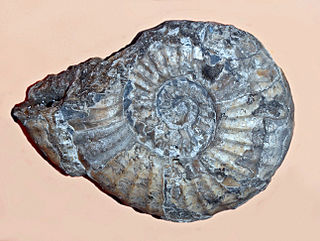
Ammonoids are extinct spiral shelled cephalopods comprising the subclass Ammonoidea. They are more closely related to living coleoids than they are to shelled nautiloids. The earliest ammonoids appeared during the Devonian, with the last species vanishing during or soon after the Cretaceous–Paleogene extinction event. They are often called ammonites, which is most frequently used for members of the order Ammonitida, the only remaining group of ammonoids from the Jurassic up until their extinction.

In mathematics, an involute is a particular type of curve that is dependent on another shape or curve. An involute of a curve is the locus of a point on a piece of taut string as the string is either unwrapped from or wrapped around the curve.

A cycloidal gear is a toothed gear with a cycloidal profile. Such gears are used in mechanical clocks and watches, rather than the involute gear form used for most other gears. Cycloidal gears have advantages over involute gears in such applications in being able to be produced flat, and having fewer points of contact.

Ceratitida is an order that contains almost all ammonoid cephalopod genera from the Triassic as well as ancestral forms from the Upper Permian, the exception being the phylloceratids which gave rise to the great diversity of post-Triassic ammonites.
Tornoceratidae is a family of goniatitid ammonoids from the middle and upper Devonian. The family is included in the suborder Tornoceratina and the superfamily Tornoceratoidea.
Bisatoceratidae is a family of Late Paleozoic ammonites now included in the Thalassoceratoidea characterized by thick-discoidal to subglobular, involute shells in which lobes are simple. Some forms have spiral ornamentation.
Thalassoceratidae a family of late Paleozoic ammonites included in the goniatitid superfamily Thalassoceratoidea along with the Bisatoceratidae. Some eight genera are included, although the specific number and exactly which depends on the particular classification.

Psiloceratoidea is a superfamily of Early Jurassic ammonoid cephalopods proposed by Hyatt in 1867, assigned to the order Ammonitida. They were very successful during Hettangian and Sinemurian. Last of them, family Cymbitidae and genera Hypoxynoticeras and Radstockiceras survived into Early Pliensbachian.
The Clydonautiloidea are a superfamily within the nautiloid order Nautilida characterized by smooth, generally globular, shells with nearly straight sutures, in early forms, but developing highly differentiated sutures in some later forms. Where known, the siphuncle tends to be central to subcentral.

The Trigonoceratoidea are a superfamily within the Nautilida that ranged from the Devonian to the Triassic, thought to have contained the source for the Nautilaceae in which Nautilus is found.
Syringonautilidae is a family of Nautiloidea from the middle to late Triassic. Syringonautilidae comprise the last of the Trigonoceratoidea and are the source for the Nautilaceae which continued the Nautiloidea through the Mesozoic and into the Cenozoic right down to the recent. Syringonautilidae is a strictly Triassic family, derived early in the Triassic from the Grypoceratidae.

Grypoceratidae is the longest-lived family of the Trigonoceratoidea, or of the near equivalent Centroceratina; members of the Nautilida from the Upper Paleozoic and Triassic.
The Centroceratidae is the ancestral family of the Trigonoceratoidea and of the equivalent Centroceratina; extinct shelled cephalopods belonging to the order Nautilida
The Clydonautilidae are Middle and Upper Triassic nautiloid cephalopods, which are derivatives of the clydonautiloidean family Liroceratidae, that have generally smooth, involute, globular to compressed shells, characterized by a suture with prominent lobes and saddles. The family is known to contain five genera, These are:
Pseudonautilidae is a family of Jurassic and Lower Cretaceous nautilid cephalopods belonging to the same superfamily as modern Nautilus, Nautilaceae, but forming a different branch from the family Nautilidae. Pseudonautilids, together with other nautilids, were contemporary with the ammonoids, which comprise an entirely different set of shelled cephalopod stocks more closely related to octopus and squid.
Falcitornoceras is a goniatitid ammonite from the Late Devonian, early Famennian, that has been found in France and Spain. Falcitornoceras was named by House and Price, 1985, and is the type genus for the subfamily Falcitornoceratinae.
Gundolficeras is member of the Tornoceratidae,, from the Late Devonian named by Becker, 1995 and assigned to the Falcitornoceratinae. The type species is "Lobotornoceras" bicaniculatum.
Phoenixites is an early genus of the Falcitornoceratinae, a subfamily of the goniatitid Tornoceratidae family. This genus was named by Becker in 1995. The type species is "Tornoceras" frechi.
Truyolsoceras is an Upper Devonian ammonite included in the goniatitid subfamily Aulatornoceratinae. The shell is involute, lenticular, with a narrow umbilicus and moderately high aperture. The adventitious lobe of the suture, which lies between the ventral and lateral lobes, is rounded.
Neoglaphyrites is a goniatitid ammonite that lived during the latest Pennsylvanian and early Permian. Its shell is ellipsoidal and moderately involute; the umbilicus deep and typically less than 15 per cent of the shell diameter but in some species closer to 20 per cent. Delicate growth lines forming ventral and lateral sinuses and ventrolateral and dorsolateral salients have been found on Canadian Arctic specimens. The suture is characterized by the ventral lobe split into two broad prongs that are separated by a high median ventral saddle; prongs closely approximate the width of the first lateral lobe. The first lateral saddle is evenly rounded and is nearly symmetrical. The umbilical lobe is V-shaped and internal lobes are deep and narrow.





